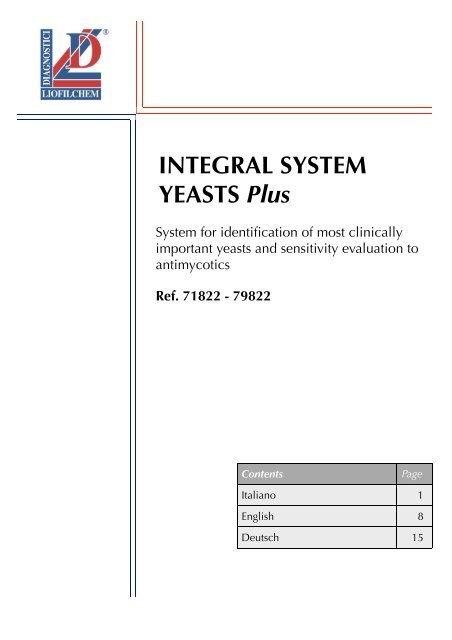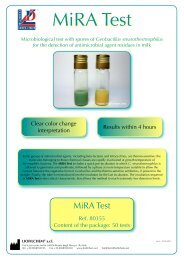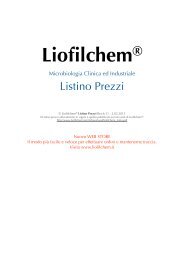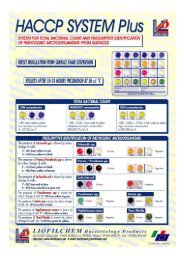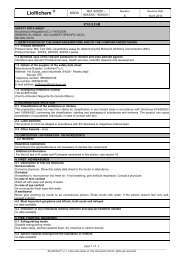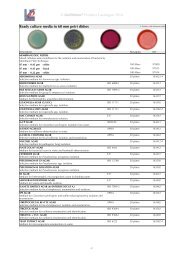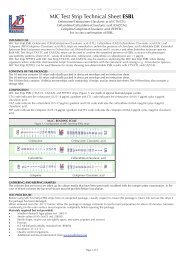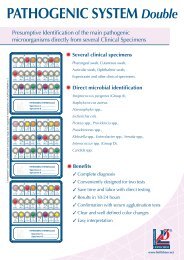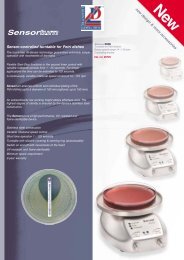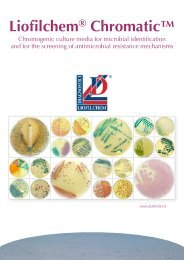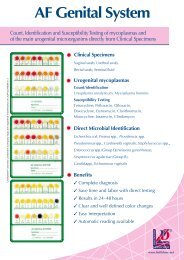INTEGRAL SYSTEM YEASTS Plus - Liofilchem® srl
INTEGRAL SYSTEM YEASTS Plus - Liofilchem® srl
INTEGRAL SYSTEM YEASTS Plus - Liofilchem® srl
You also want an ePaper? Increase the reach of your titles
YUMPU automatically turns print PDFs into web optimized ePapers that Google loves.
<strong>INTEGRAL</strong> <strong>SYSTEM</strong><br />
<strong>YEASTS</strong> <strong>Plus</strong><br />
System for identification of most clinically<br />
important yeasts and sensitivity evaluation to<br />
antimycotics<br />
Ref. 71822 - 79822<br />
Contents Page<br />
Italiano 1<br />
English 8<br />
Deutsch 15
Code F14113<br />
Rev.4 / 25.07.2012
Liofilchem ® - <strong>INTEGRAL</strong> <strong>SYSTEM</strong> YEAST <strong>Plus</strong> - (Ref. 71822 – 79822) - Rev.4 / 25.07.2012<br />
<strong>INTEGRAL</strong> <strong>SYSTEM</strong> <strong>YEASTS</strong> <strong>Plus</strong><br />
ITALIANO<br />
DESCRIZIONE<br />
<strong>INTEGRAL</strong> <strong>SYSTEM</strong> <strong>YEASTS</strong> <strong>Plus</strong> è un sistema a 24 pozzetti contenente substrati biochimici ed antimicotici<br />
essiccati per l'identificazione e la valutazione della sensibilità agli antimicotici dei lieviti di maggior importanza<br />
clinica. Il sistema viene inoculato con la sospensione cellulare ed incubato a 36 ± 1°C per 48 ore.<br />
CONTENUTO DELLE CONFEZIONI<br />
La confezione contiene:<br />
Ref. 71822 20 Sistemi <strong>INTEGRAL</strong> <strong>SYSTEM</strong> <strong>YEASTS</strong> <strong>Plus</strong> 40 Fiale di Physiological Solution (4.5 mL/fiala)<br />
Ref. 79822 4 Sistemi <strong>INTEGRAL</strong> <strong>SYSTEM</strong> <strong>YEASTS</strong> <strong>Plus</strong> 8 Fiale di Physiological Solution (4.5 mL/fiala)<br />
1 Cartuccia di Xylose Disc - 1 Foglio Istruzioni - 1 Modulo Risposta Esame<br />
PRODOTTI NECESSARI NON CONTENUTI<br />
Olio di vaselina per uso microbiologico (VASELINE OIL: 2 flaconi da 50 mL, ref. 80278)<br />
Materiale vario per laboratorio di microbiologia<br />
CONFIGURAZIONE<br />
Il sistema presenta la configurazione indicata in Tabella n.1.<br />
Tabella n.1<br />
Pozzetto TEST DI ASSIMILAZIONE Pozzetto REAZIONE CROMATICA<br />
1-GLU Glucosio 13-CHR Substrato cromogenico<br />
2-MAL Maltosio Pozzetto TEST ANTIBIOGRAMMA<br />
3-SAC Saccarosio 14-NY Nistatina 1.25 !g/mL<br />
4-LAC Lattosio 15-AMB Amfotericina 2 !g/mL<br />
5-GAL Galattosio 16-FCY Flucitosina 16 !g/mL<br />
6-MEL Melibiosio 17-ECN Econazolo 2 !g/mL<br />
7-CEL Cellobiosio 18-KCA Ketoconazolo 0.5 !g/mL<br />
8-INO Inositolo 19-CLO Clotrimazolo 1 !g/mL<br />
9-XYL Xylosio 20-MIC Miconazolo 2 !g/mL<br />
10-RAF Raffinosio 21-ITR Itraconazolo 1 !g/mL<br />
11-TRE Trealosio 22-VOR Voriconazolo 2 !g/mL<br />
12-DUL Dulcitolo 23-FLU Fluconazolo 64 !g/mL<br />
24-C Controllo di crescita<br />
PRINCIPIO DEL METODO<br />
<strong>INTEGRAL</strong> <strong>SYSTEM</strong> <strong>YEASTS</strong> <strong>Plus</strong> permette:<br />
! Identificazione presuntiva. È basata sulle reazioni di assimilazione degli zuccheri; i test per le reazioni di assimilazione<br />
vengono interpretati valutando il viraggio di colore dei pozzetti da 1-GLU a 12-DUL. La combinazione delle reazioni positive e<br />
negative permette la formazione di un codice numerico che consente a sua volta di identificare, con l’aiuto della TABELLA DEI<br />
CODICI, i lieviti in esame.<br />
Il pozzetto 13-CHR contiene un substrato cromogenico che permette di differenziare alcuni lieviti sulla base della colorazione<br />
assunta dal pozzetto.<br />
! Sensibilità agli antimicotici. I test vengono valutati in base alla crescita o all'inibizione dei lieviti in terreni contenenti l'antimicotico<br />
ed un indicatore di crescita nei pozzetti da 14-NY a 23-FLU.<br />
Il viraggio di colore daI rosso all'arancio dei pozzetti indica una crescita lenta del lievito in esame e dunque una sensibilità<br />
intermedia alla concentrazione di antimicotico del pozzetto.<br />
Il viraggio di colore daI rosso al giallo dei pozzetti indica una crescita del lievito in esame e dunque una resistenza alla<br />
concentrazione di antimicotico del pozzetto.<br />
Il mancato viraggio del pozzetto indica una mancata crescita del lievito in esame e dunque una sensibilità alla concentrazione di<br />
antimicotico del pozzetto.<br />
Il pozzetto 24-Growth non contiene antimicotici ma solo terreno colturale e l'indicatore e serve come controllo di crescita.<br />
1
COMPOSIZIONE<br />
Tabella n.2<br />
Pozzetto Contenuto<br />
Liofilchem ® - <strong>INTEGRAL</strong> <strong>SYSTEM</strong> YEAST <strong>Plus</strong> - (Ref. 71822 – 79822) - Rev.4 / 25.07.2012<br />
1-GLU Terreno colturale per l'assimilazione del glucosio<br />
2-MAL Terreno colturale per l'assimilazione del maltosio<br />
3-SAC Terreno colturale per l'assimilazione del saccarosio<br />
4-LAC Terreno colturale per l'assimilazione del lattosio<br />
5-GAL Terreno colturale per l'assimilazione del galattosio<br />
6-MEL Terreno colturale per l'assimilazione del melibiosio<br />
7-CEL Terreno colturale per l'assimilazione del cellobiosio<br />
8-INO Terreno colturale per l'assimilazione dell'inositolo<br />
9-XYL Terreno colturale per l'assimilazione dello xilosio<br />
10-RAF Terreno colturale per l'assimilazione del raffinosio<br />
11-TRE Terreno colturale per l'assimilazione del trealosio<br />
12-DUL Terreno colturale per l'assimilazione del dulcitolo<br />
13-CHR Terreno colturale cromogenico<br />
14-NY Terreno colturale contenente Nistatina - 1.25 µg/mL<br />
15-AMB Terreno colturale contenente Amfotericina - 2 µg/mL<br />
16-FCY Terreno colturale contenente Flucitosina - 16 µg/mL<br />
17-ECN Terreno colturale contenente Econazolo - 2 µg/mL<br />
18-KCA Terreno colturale contenente Ketaconazolo – 0.5 µg/mL<br />
19-CLO Terreno colturale contenente Clotrimazolo - 1 µg/mL<br />
20-MIC Terreno colturale contenente Miconazolo - 2 µg/mL<br />
21-ITR Terreno colturale contenente Itraconazolo - 1 µg/mL<br />
22-VOR Terreno colturale contenente Voriconazolo - 2 µg/mL<br />
23-FLU Terreno colturale contenente Fluconazolo - 64 µg/mL<br />
24-Growth Terreno colturale per il controllo di crescita<br />
Physiological Solution (g\L): Sodio cloruro 9 g; Acqua distillata 1000 mL; pH 6.8 ± 0.2<br />
2
Liofilchem ® - <strong>INTEGRAL</strong> <strong>SYSTEM</strong> YEAST <strong>Plus</strong> - (Ref. 71822 – 79822) - Rev.4 / 25.07.2012<br />
RACCOLTA E CONSERVAZIONE DEI CAMPIONI<br />
<strong>INTEGRAL</strong> <strong>SYSTEM</strong> <strong>YEASTS</strong> <strong>Plus</strong> viene utilizzato per l'identificazione e la valutazione della sensibilità agli<br />
antimicotici di lieviti di importanza clinica isolati su terreni colturali selettivi per l'isolamento dei lieviti.<br />
PROCEDURA DEL TEST<br />
1) PREPARAZIONE DELLA SOSPENSIONE CELLULARE<br />
! Prelevare una o più colonie microbiche e sospenderle in una fiala di Physiological Solution contenuta nel<br />
kit fino ad ottenere una torbidità pari a 0.5 Mc Farland (ref. 80400) (Sospensione A).<br />
! Dispensare 0.02 mL di Sospensione A in un'altra fiala di Physiological Solution contenuta nel kit<br />
(Sospensione B).<br />
2) INOCULO DEL SISTEMA<br />
! Prelevare un sistema dal suo involucro e portarlo a temperatura ambiente.<br />
! Annotare nome, data e provenienza del microrganismo.<br />
! Inserire un dischetto di xilosio nel pozzetto 9-XYL.<br />
! Trasferire 0.2 mL (4 gocce) di Sospensione A nei pozzetti da 1-GLU a 13-CHR.<br />
! Trasferire 0.2 mL (4 gocce) di Sospensione B nei pozzetti 14-NY a 24-Growth.<br />
! Coprire con una goccia di olio di vasellina tutti i pozzetti del sistema ad eccezione del pozzetto 13-CHR.<br />
! Coprire il sistema con l’apposito coperchio ed incubare a 36 ± 1°C per 48 ore.<br />
INTERPRETAZIONE DEI RISULTATI<br />
IDENTIFICAZIONE<br />
! Osservare il viraggio di colore dei pozzetti da 1-GLU a 12- DUL ed interpretare i risultati servendosi della<br />
Tabella n.3.<br />
! Trascrivere i risultati ottenuti nell’apposito Modulo Risposta Esame (Fotocopiare il numero necessario di<br />
moduli).<br />
! Formare il codice numerico di 4 cifre seguendo le istruzioni riportate nel paragrafo FORMAZIONE DEL<br />
CODICE NUMERICO.<br />
! Risalire quindi all’identificazione del microrganismo servendosi della Tabella dei codici.<br />
! Valutare il colore del pozzetto 13-CHR.<br />
Tabella n.3<br />
Pozzetto IDENTICAZIONE DEI LIEVITI<br />
Colore pozzetto<br />
Reazione positiva Reazione negativa<br />
1-GLU Glucosio Giallo-grigio Viola porpora<br />
2-MAL Maltosio Giallo-grigio Viola porpora<br />
3-SAC Saccarosio Giallo-grigio Viola porpora<br />
4-LAC Lattosio Giallo-grigio Viola porpora<br />
5-GAL Galattosio Giallo-grigio Viola porpora<br />
6-MEL Melibiosio Giallo-grigio Viola porpora<br />
7-CEL Cellobiosio Giallo-grigio Viola porpora<br />
8-INO Inositolo Giallo-grigio Viola porpora<br />
9-XYL Xilosio Giallo-grigio Viola porpora<br />
10-RAF Raffinosio Giallo-grigio Viola porpora<br />
11-TRE Trealosio Giallo-grigio Viola porpora<br />
12-DUL Dulcitolo Giallo-grigio Viola porpora<br />
3
FORMAZIONE DEL CODICE NUMERICO<br />
Liofilchem ® - <strong>INTEGRAL</strong> <strong>SYSTEM</strong> YEAST <strong>Plus</strong> - (Ref. 71822 – 79822) - Rev.4 / 25.07.2012<br />
1. I 12 test biochimici sono divisi in 4 gruppi contenenti 3 test ed ogni test viene indicato con un valore di<br />
positività di 1,2,4.<br />
Valore 1 : primo test positivo di ogni gruppo (1-GLU, 4-LAC, 7-CEL, 10-RAF)<br />
Valore 2 : secondo test positivo di ogni gruppo (2-MAL, 5-GAL, 8-INO, 11-TRE)<br />
Valore 4 : terzo test positivo di ogni gruppo (3-SAC, 6-MEL, 9-XYL, 12-DUL)<br />
Valore 0 : ogni test negativo<br />
2. Addizionando in ogni gruppo i numeri delle reazioni positive, si ottiene un codice a 4 cifre che, servendosi<br />
della Tabella dei codici, permette di identificare il microrganismo in esame come da esempio.<br />
Gruppo 1 Gruppo 2 Gruppo 3 Gruppo 4<br />
Test 1-GLU 2-MAL 3-SAC 4-LAC 5-GAL 6-MEL 7-CEL 8-INO 9-XYL 10-RAF 11-TRE 12-DUL<br />
Codice di positività 1 2 4 1 2 4 1 2 4 1 2 4<br />
Risultati + + + - + - - - + - + -<br />
Somma dei codici 7 2 4 2<br />
CODICE 7242 MICRORGANISMO Candida albicans<br />
TABELLA DELLE REAZIONI<br />
Glucosio Maltosio Saccarosio Lattosio Galattosio Melibiosio Cellobiosio Inositolo Xylosio Raffinosio Trealosio Dulcitolo<br />
Candida albicans + + + - + - - - + - + -<br />
Candida catenulata + + - - + - - - + - - -<br />
Candida dubliniensis + + + - + - - - - - - -<br />
Candida famata + + + v + + + - + + + v<br />
Candida glabrata + - - - - - - - - - + -<br />
Candida guillermondii + + + - + + + - + + + +<br />
Candida kefyr + - + + + - v - v + v -<br />
Candida krusei + - - - - - - - - - - -<br />
Candida lambica + - - - - - - - + - - -<br />
Candida lusitaniae + + + - + - + - + - + -<br />
Candida parapsilosis + + + - + - - - + - - -<br />
Candida rugosa + - - - + - - - v - - -<br />
Candida tropicalis + + + - + - v - + - + -<br />
Candida zeylanoides + - - - v - v - - - + -<br />
Candida pseudotropicalis + - + + + - + - v + - -<br />
Candida stellatoidea + + - - + - - - + - + -<br />
Crytococcus neoformans + + + - + - + + + v + +<br />
Cryptococcus albidus + + + v v + + + + + + v<br />
Crytococcus laurentii + + + + + v + + + v + +<br />
Crytococcus luteolus + + + - + + + + + + + +<br />
Cryptococcus terreus + v - v v - + + + - + v<br />
Cryptococcus uniguttulatus + + + - v - v + + v v -<br />
Cryptococcus gastricus + + - v + - + + + - + -<br />
Rhodotorula glutinis + + + - v - + - + + + -<br />
Rhodotorula rubra + + + - + - v - + + + -<br />
Saccharomyces cerevisiae + + + - + - - - - + v -<br />
Hansenulaanomala + + + - + - + - + - + -<br />
Geotrichum candidum + - - - + - - - + - - -<br />
Blastoschizomyces capitatus + - - - + - - - - - - -<br />
Prototheca wickerhamii + - - - + - - - - - + -<br />
Trichosporon capitatum + - - - + - - - - - - -<br />
Trichosporon pullulans + + + + + + + v v + + -<br />
4
TABELLA DEI CODICI<br />
CODICE MICRORGANISMO<br />
Liofilchem ® - <strong>INTEGRAL</strong> <strong>SYSTEM</strong> YEAST <strong>Plus</strong> - (Ref. 71822 – 79822) - Rev.4 / 25.07.2012<br />
COLORE<br />
POZZETTO 13<br />
1000 Candida krusei ROSA<br />
1002<br />
Candida zeylanoides<br />
Candida glabrata<br />
1012 Candida zeylanoides -<br />
1040 Candida lambica -<br />
1072 Cryptococcus terreus -<br />
1076 Cryptococcus terreus -<br />
1172 Cryptococcus terreus -<br />
1176 Cryptococcus terreus -<br />
1200<br />
1202<br />
Trichosporon capitatum<br />
Blastoschizomyces<br />
capitatus<br />
Candida rugosa<br />
Prototheca wickerhamii<br />
Candida zeylanoides<br />
1212 Candida zeylanoides -<br />
1240<br />
Geotrichum candidum<br />
Candida rugosa<br />
1272 Cryptococcus terreus -<br />
1276 Cryptococcus terreus -<br />
1372 Cryptococcus terreus -<br />
1376 Cryptococcus terreus -<br />
3072 Cryptococcus terreus -<br />
3076 Cryptococcus terreus -<br />
3172 Cryptococcus terreus -<br />
3176 Cryptococcus terreus -<br />
3240 Candida catenulata -<br />
3242 Candida stellatoidea -<br />
3272<br />
Cryptococcus gastricus<br />
Cryptococcus terreus<br />
3276 Cryptococcus terreus -<br />
3372<br />
Cryptococcus gastricus<br />
Cryptococcus terreus<br />
3376 Cryptococcus terreus -<br />
5303 Candida kefyr -<br />
5311<br />
Candida pseudotropicalis<br />
Candida kefyr<br />
5313 Candida kefyr -<br />
5341 Candida kefyr -<br />
5343 Candida kefyr -<br />
5351<br />
Candida pseudotropicalis<br />
Candida kefyr<br />
5353 Candida kefyr -<br />
7053 Rhodotorula glutinis -<br />
7060 Cryptococcus uniguttulatus -<br />
7061 Cryptococcus uniguttulatus -<br />
7062 Cryptococcus uniguttulatus -<br />
7063 Cryptococcus uniguttulatus -<br />
-<br />
-<br />
-<br />
-<br />
CARATTERISTICHE DIFFERENZIALI E MORFOLOGIA MICROSCOPICA DI COLONIE<br />
CRESCIUTE SU CORN MEAL AGAR (Ref. 11507) A 25°C<br />
Candida krusei presenta pseudoife estremamente allungate, raramente ramificate; pochi<br />
blastoconidi.<br />
Candida zeylanoides presenta pseudoife, con formazione di blastoconidi.<br />
Candida glabrata presenta spore piccole con assenza di pseudoife.<br />
Trichosporum capitatum presenta ife e pseudoife, artroconidi e blastoconidi.<br />
Blastoschizomyces capitatus presenta ife e anelloconidi assomiglianti agli artroconidi.<br />
Candida rugosa presenta pseudoife e blastoconidi<br />
Prototheca wickerhamii presenta spore, senza formazione di ife.<br />
Candida zeylanoides presenta pseudoife, con formazione di blastoconidi<br />
Geotrichum candidum presenta artroconidi.<br />
Candida rugosa presenta pseudoife e blastoconidi.<br />
- Cryptococcus gastricus non cresce a 37 °C su Sabouraud Dextrose Agar.<br />
- Cryptococcus terreus cresce a 37 °C su Sabouraud Dextrose Agar.<br />
- Cryptococcus gastricus non cresce a 37 °C su Sabouraud Dextrose Agar.<br />
- Cryptococcus terreus cresce a 37 °C su Sabouraud Dextrose Agar.<br />
- Candida pseudotropicalis presenta blastoconidi allungati lungo le pseudoife.<br />
- Candida kefyr presenta pseudoife lunghe e abbondanti con blastoconidi ovali e allungati.<br />
- Candida pseudotropicalis presenta blastoconidi allungati lungo le pseudoife.<br />
- Candida kefyr presenta pseudoife lunghe e abbondanti con blastoconidi ovali e allungati.<br />
5
CODICE MICRORGANISMO<br />
Liofilchem ® - <strong>INTEGRAL</strong> <strong>SYSTEM</strong> YEAST <strong>Plus</strong> - (Ref. 71822 – 79822) - Rev.4 / 25.07.2012<br />
COLORE<br />
POZZETTO 13<br />
7070 Cryptococcus uniguttulatus -<br />
7071 Cryptococcus uniguttulatus -<br />
7072 Cryptococcus uniguttulatus -<br />
7073 Cryptococcus uniguttulatus -<br />
7200 Candida dubliniensis -<br />
7201 Saccharomyces cerevisiae -<br />
7203 Saccharomyces cerevisiae -<br />
7240 Candida parapsilosis -<br />
7242<br />
Candida albicans<br />
Candida tropicalis<br />
VERDE<br />
BLU<br />
7243 Rhodotorula rubra -<br />
7252<br />
7253<br />
Hansenula anomala<br />
Candida tropicalis<br />
Candida lusitaniae<br />
Rhodotorula rubra<br />
Rhodotorula glutinis<br />
CARATTERISTICHE DIFFERENZIALI E MORFOLOGIA MICROSCOPICA DI COLONIE<br />
CRESCIUTE SU CORN MEAL AGAR (Ref. 11507) A 25°C<br />
Candida albicans presenta pseudoife con clamidospore terminali.<br />
Candida tropicalis presenta blastoconidi ovunque lungo le pseudoife.<br />
- Hansenula anomala presenta blastoconidi con ascospore e assenza di pseudoife.<br />
BLU Candida tropicalis presenta blastoconidi ovunque lungo le pseudoife.<br />
INCOLORE<br />
7260 Cryptococcus uniguttulatus -<br />
7261 Cryptococcus uniguttulatus -<br />
7262 Cryptococcus uniguttulatus -<br />
7263 Cryptococcus uniguttulatus -<br />
7270 Cryptococcus uniguttulatus -<br />
7271 Cryptococcus uniguttulatus -<br />
7272 Cryptococcus uniguttulatus -<br />
7273 Cryptococcus uniguttulatus -<br />
7276 Cryptococcus neoformans -<br />
7277 Cryptococcus neoformans -<br />
7376 Cryptococcus laurentii -<br />
7377 Cryptococcus laurentii -<br />
7473 Cryptococcus albidus -<br />
7477 Cryptococcus albidus -<br />
7573 Cryptococcus albidus -<br />
7577 Cryptococcus albidus -<br />
7653 Candida famata -<br />
7657<br />
Candida guillermondii<br />
Candida famata<br />
7673 Cryptococcus albidus -<br />
7677<br />
Cryptococcus luteolus<br />
Cryptococcus albidus<br />
7713 Trichosporon pullulans -<br />
7733 Trichosporon pullulans -<br />
7753<br />
Trichosporon pullulans<br />
Candida famata<br />
7757 Candida famata -<br />
7773<br />
Trichosporon pullulans<br />
Cryptococcus albidus<br />
7776 Cryptococcus laurentii -<br />
7777<br />
Cryptococcus laurentii<br />
Cryptococcus albidus<br />
-<br />
Candida lusitaniae presenta corte catene di blastoconidi allungati lungo pseudoife a<br />
forma curva.<br />
Rhodotorula glutinis e Rhodotorula rubra non formano pseudoife.<br />
Rhodotorula glutinis utilizza il KNO3 Rhodotorula rubra non utilizza il KNO3<br />
- Candida guillermondii forma pseudoife corte con ai setti gruppi di blastoconidi.<br />
- Candida famata non forma pseudoife.<br />
- Cryptococcus luteolus utilizza il KNO3.<br />
- Cryptococcus albidus non utilizza il KNO3.<br />
- Trichosporon pullulans presenta ife e pseudoife, artroconidi e blastoconidi.<br />
- Candida famata presenta blastoconidi, non forma pseudoife.<br />
- Trichosporon pullulans presenta ife e pseudoife, artroconidi e blastoconidi.<br />
- Cryptococcus albidus presenta spore rotonde e scure; non forma ife<br />
- Cryptococcus laurentii cresce a 37 °C su Sabouraud Dextrose Agar.<br />
- Cryptococcus albidus non cresce a 37 °C su Sabouraud Dextrose Agar.<br />
6
SENSIBILITÀ<br />
AGLI ANTIMICOTICI<br />
Liofilchem ® - <strong>INTEGRAL</strong> <strong>SYSTEM</strong> YEAST <strong>Plus</strong> - (Ref. 71822 – 79822) - Rev.4 / 25.07.2012<br />
Osservare il viraggio di colore dei pozzetti ed interpretare i risultati servendosi della Tabella n.4.<br />
Trascrivere i dati nell’apposito Modulo Risposta Esame.<br />
Il pozzetto di controllo (24-Growth) deve risultare positivo (giallo).<br />
Tabella n.4<br />
COLORE POZZETTO CRESCITA BATTERICA INTERPRETAZIONE<br />
Rosso Inibita S = Sensibile<br />
Arancio Parzialmente inibita I = Intermedio<br />
Giallo Buona R = Resistente<br />
CONTROLLO QUALITÀ<br />
Ogni lotto di <strong>INTEGRAL</strong> <strong>SYSTEM</strong> <strong>YEASTS</strong> <strong>Plus</strong> viene sottoposto al controllo qualità utilizzando i microrganismi<br />
di riferimento seguenti:<br />
Candida albicans ATCC 90028<br />
Candida krusei ATCC 6258<br />
Candida tropicalis ATCC 750<br />
Candida parapsilosis ATCC 22019<br />
FATTORI CHE POSSONO INVALIDARE I RISULTATI<br />
Imprecisa standardizzazione dell’inoculo; applicazione del metodo a microrganismi non appartenenti al gruppo<br />
dei lieviti; non corretta applicazione della tecnica d’uso; temperatura e tempi di incubazione non rispettati.<br />
PRECAUZIONI<br />
Il prodotto <strong>INTEGRAL</strong> <strong>SYSTEM</strong> <strong>YEASTS</strong> <strong>Plus</strong> non è classificabile come pericoloso ai sensi della legislazione<br />
vigente; per un suo corretto impiego si consiglia comunque di consultare la Scheda di Sicurezza.<br />
<strong>INTEGRAL</strong> <strong>SYSTEM</strong> <strong>YEASTS</strong> <strong>Plus</strong> è un dispositivo monouso da usare solo per uso diagnostico in vitro, è<br />
destinato ad un ambito professionale e deve essere usato in laboratorio da operatori adeguatamente addestrati<br />
con metodi approvati di asepsi e di sicurezza nei confronti degli agenti patogeni.<br />
CONSERVAZIONE<br />
Conservare a 2-8 °C nella sua confezione originale. Non conservare vicino a fonti di calore ed evitare eccessive<br />
variazioni di temperatura. In queste condizioni il prodotto è valido fino alla data di scadenza indicata in etichetta.<br />
Non utilizzare oltre questa data. Eliminare se vi sono segni di deterioramento.<br />
ELIMINAZIONE DEL MATERIALE USATO<br />
Dopo l’utilizzazione, <strong>INTEGRAL</strong> <strong>SYSTEM</strong> <strong>YEASTS</strong> <strong>Plus</strong> ed il materiale venuto a contatto con il campione<br />
devono essere decontaminati e smaltiti in accordo con le tecniche in uso in laboratorio per la decontaminazione<br />
e lo smaltimento di materiale potenzialmente infetto.<br />
PRESENTAZIONE<br />
Prodotto Ref. Confezione<br />
<strong>INTEGRAL</strong> <strong>SYSTEM</strong> <strong>YEASTS</strong> <strong>Plus</strong> 71822 20 test<br />
<strong>INTEGRAL</strong> <strong>SYSTEM</strong> <strong>YEASTS</strong> <strong>Plus</strong> 79822 4 test<br />
TABELLA DEI SIMBOLI<br />
Dispositivo medico<br />
diagnostico in vitro<br />
Numero di catalogo Fragile, maneggiare<br />
con cura<br />
Non riutilizzare Fabbricante<br />
Utilizzare<br />
entro<br />
7<br />
Contenuto sufficiente<br />
per saggi<br />
Attenzione, vedere le<br />
istruzioni per l’uso<br />
Limiti di<br />
temperatura<br />
Codice del lotto
Liofilchem ® - <strong>INTEGRAL</strong> <strong>SYSTEM</strong> YEAST <strong>Plus</strong> - (Ref. 71822 – 79822) - Rev.4 / 25.07.2012<br />
<strong>INTEGRAL</strong> <strong>SYSTEM</strong> <strong>YEASTS</strong> <strong>Plus</strong><br />
ENGLISH<br />
DESCRIPTION<br />
<strong>INTEGRAL</strong> <strong>SYSTEM</strong> <strong>YEASTS</strong> <strong>Plus</strong> is a 24 wells system containing biochemical substrata and dried<br />
antimycotics for the identification of the most clinically important yeasts and sensitivity evaluation to antimycotics.<br />
The system is inoculated with the cell suspension and incubated at 36 ± 1°C for 48 hours.<br />
KIT CONTENTS<br />
The kit contains:<br />
Ref. 71822 20 Systems <strong>INTEGRAL</strong> <strong>SYSTEM</strong> <strong>YEASTS</strong> <strong>Plus</strong> 40 Vials of Physiological Solution (4.5 mL/vial)<br />
Ref. 79822 4 Systems <strong>INTEGRAL</strong> <strong>SYSTEM</strong> <strong>YEASTS</strong> <strong>Plus</strong> 8 Vials of Physiological Solution (4.5 mL/vial)<br />
1 Cartridge of Xylose Disc - 1 Instructions Sheet - 1 Test Results Form<br />
ITEMS NECESSARY BUT NOT INCLUDED IN THE KIT<br />
Vaseline oil for microbiological use (VASELINE OIL: 2 bottles x 50 mL, ref.80278)<br />
Various materials for laboratory of microbiology<br />
CONFIGURATION<br />
The configuration of the system is shown in Table no.1:<br />
Table no.1<br />
Well ASSIMILATION Well CHROMATIC REACTION<br />
1-GLU Glucose 13-CHR Chromogenic substrate<br />
2-MAL Maltose Well ANTIMYCOTICS<br />
3-SAC Saccarose 14-NY Nistatin 1.25 !g/mL<br />
4-LAC Lactose 15-AMB Amphotericin 2 !g/mL<br />
5-GAL Galactose 16-FCY Flucytosine 16 !g/mL<br />
6-MEL Melibiose 17-ECN Econazole 2 !g/mL<br />
7-CEL Cellobiose 18-KCA Ketoconazole 0.5 !g/mL<br />
8-INO Inositol 19-CLO Clotrimazole 1 !g/mL<br />
9-XYL Xylose 20-MIC Miconazole 2 !g/mL<br />
10-RAF Raffinose 21-ITR Itraconazole 1 !g/mL<br />
11-TRE Trehalose 22-VOR Voriconazole 2 !g/mL<br />
12-DUL Dulcitol 23-FLU Fluconazole 64 !g/mL<br />
24-Growth Growth control<br />
PRINCIPLE OF THE METHOD<br />
<strong>INTEGRAL</strong> <strong>SYSTEM</strong> <strong>YEASTS</strong> <strong>Plus</strong> allows:<br />
! Presumptive Identification. It is based on assimilation reactions of sugars; the tests for the assimilation reactions are<br />
interpreted by evaluating the color change of wells 1-GLU to 12-DUL. The combination of positive and negative reactions<br />
allows the formation of a numerical code which permits to identify the yeasts under examination, through the use of the<br />
TABLE OF CODES.<br />
The well 13-CHR contains a chromogenic substrate that permits to differentiate some yeasts by evaluating the color change<br />
of the well.<br />
! Sensitivity to antimycotics. The tests are evaluated according to growth or inhibition of yeasts in media containing the<br />
antimycotic and a growth indicator in the wells 14-NY to 23-FLU.<br />
The color change from red to orange in the wells indicates a slow growth of the yeast under examination and an<br />
intermediate sensitivity to the concentration of antimycotic in the well.<br />
The color change from red to yellow in the wells indicates a growth of the yeast under examination and resistance to the<br />
concentration of antimycotic in the well.<br />
No color change in the well indicates no growth of the yeast under examination and sensitivity to the concentration of<br />
antimycotic in the well.<br />
The well 24-Growth does not contain antimycotics, it contains culture medium and indicator and it works as growth control.<br />
8
COMPOSITION<br />
Table no.2<br />
Well Content<br />
Liofilchem ® - <strong>INTEGRAL</strong> <strong>SYSTEM</strong> YEAST <strong>Plus</strong> - (Ref. 71822 – 79822) - Rev.4 / 25.07.2012<br />
1-GLU Culture medium for the assimilation of glucose<br />
2-MAL Culture medium for the assimilation of maltose<br />
3-SAC Culture medium for the assimilation of saccarose<br />
4-LAC Culture medium for the assimilation of lactose<br />
5-GAL Culture medium for the assimilation of galactose<br />
6-MEL Culture medium for the assimilation of melibiose<br />
7-CEL Culture medium for the assimilation of cellobiose<br />
8-INO Culture medium for the assimilation of inositol<br />
9-XYL Culture medium for the assimilation of xylose<br />
10-RAF Culture medium for the assimilation of raffinose<br />
11-TRE Culture medium for the assimilation of trehalose<br />
12-DUL Culture medium for the assimilation of dulcitol<br />
13-CHR Culture medium containing chromogenic substratum<br />
14-NY Culture medium containing Nistatin - 1.25 µg/mL<br />
15-AMB Culture medium containing Amphotericin - 2 µg/mL<br />
16-FCY Culture medium containing Flucytosine - 16 µg/mL<br />
17-ECN Culture medium containing Econazole - 2 µg/mL<br />
18-KCA Culture medium containing Ketaconazole – 0.5 µg/mL<br />
19-CLO Culture medium containing Clotrimazole - 1 µg/mL<br />
20-MIC Culture medium containing Miconazole - 2 µg/mL<br />
21-ITR Culture medium containing Itraconazole - 1 µg/mL<br />
22-VOR Culture medium containing Voriconazole - 2 µg/mL<br />
23-FLU Culture medium containing Fluconazole - 64 µg/mL<br />
24-Growth Culture medium for the growth control<br />
Physiological Solution (g\L): Sodium chloride 9 g; Distilled water 1000 mL; pH 6.8 ± 0.2<br />
9
Liofilchem ® - <strong>INTEGRAL</strong> <strong>SYSTEM</strong> YEAST <strong>Plus</strong> - (Ref. 71822 – 79822) - Rev.4 / 25.07.2012<br />
COLLECTION AND STORAGE OF THE SAMPLES<br />
<strong>INTEGRAL</strong> <strong>SYSTEM</strong> <strong>YEASTS</strong> <strong>Plus</strong> is used for the identification of the most clinically important yeasts and<br />
sensitivity evaluation to antimycotics isolated on selective culture media for the isolation of yeasts.<br />
TEST PROCEDURE<br />
1) PREPARATION OF THE CELL SUSPENSION<br />
! Take one or more microbial colonies and suspend in a Physiological Solution vial contained in the kit till<br />
obtaining a 0.5 Mc Farland turbidity (ref. 80400) (Suspension A).<br />
! Dispense 0.02 mL of Suspension A into another Physiological Solution vial contained in the kit<br />
(Suspension B).<br />
2) INOCULATION OF THE <strong>SYSTEM</strong><br />
! Take a system from its wrapper and bring it to room temperature.<br />
! Take note of name, date and origin of the microorganism.<br />
! Insert one xylose disc in the well 9-XYL.<br />
! Transfer 0.2 mL (4 drops) of Suspension A into wells 1-GLU to 13-CHR.<br />
! Transfer 0.2 mL (4 drops) of Suspension B into wells 14-NY to 24-Growth.<br />
! Cover all wells of the system with one drop of vaseline oil except 13-CHR.<br />
! Cover the system with the provided lid and incubate at 36 ± 1 °C for 48 hours.<br />
INTERPRETATION OF THE RESULTS<br />
IDENTIFICATION<br />
! Observe the color change in the wells 1-GLU to 12- DUL and interpret the results using the table no.3.<br />
! Write down the obtained results on the Test Result Form (copy as many forms as necessary).<br />
! Obtain the 4 digit code following the instructions reported in the paragraph NUMERICAL CODE<br />
FORMATION.<br />
! Finally, identify the microorganism using the Table of codes.<br />
! Observe the color change of the well 13-CHR.<br />
Table no.3<br />
Well IDENTICATION OF <strong>YEASTS</strong><br />
Well color<br />
Positive reaction Negative reaction<br />
1-GLU glucose yellow-grey purple<br />
2-MAL maltose yellow-grey purple<br />
3-SAC saccarose yellow-grey purple<br />
4-LAC lactose yellow-grey purple<br />
5-GAL galactose yellow-grey purple<br />
6-MEL melibiose yellow-grey purple<br />
7-CEL cellobiose yellow-grey purple<br />
8-INO inositol yellow-grey purple<br />
9-XYL xylose yellow-grey purple<br />
10-RAF raffinose yellow-grey purple<br />
11-TRE trehalose yellow-grey purple<br />
12-DUL dulcitol yellow-grey purple<br />
10
NUMERICAL CODE FORMATION<br />
Liofilchem ® - <strong>INTEGRAL</strong> <strong>SYSTEM</strong> YEAST <strong>Plus</strong> - (Ref. 71822 – 79822) - Rev.4 / 25.07.2012<br />
1) The 12 biochemical tests are divided into 4 groups, each containing 3 tests and every test is indicated with a<br />
positivity value of 1, 2, or 4.<br />
" value 1 : first positive test of each group (1-GLU, 4-LAC, 7-CEL, 10-RAF)<br />
" value 2 : second positive test of each group (2-MAL, 5-GAL, 8-INO, 11-TRE)<br />
" value 4 : third positive test of each group (3-SAC, 6-MEL, 9-XYL, 12-DUL)<br />
" value 0 : every negative test<br />
2) Through the sum in every group of the positive reaction values, a 4 digit code is obtainable, which allows the<br />
identification of the microorganism under examination by using the Table of codes, as in the following<br />
example.<br />
Group 1 Group 2 Group 3 Group 4<br />
Test 1-GLU 2-MAL 3-SAC 4-LAC 5-GAL 6-MEL 7-CEL 8-INO 9-XYL 10-RAF 11-TRE 12-DUL<br />
Code of positivity 1 2 4 1 2 4 1 2 4 1 2 4<br />
Results + + + - + - - - + - + -<br />
Sum of codes 7 2 4 2<br />
CODE 7242 MICROORGANISM Candida albicans<br />
TABLE OF REACTIONS<br />
glucose maltose sucrose lactose galactose melibiose cellobiose inositol xylose raffinose trehalose dulcitol<br />
Candida albicans + + + - + - - - + - + -<br />
Candida catenulata + + - - + - - - + - - -<br />
Candida dubliniensis + + + - + - - - - - - -<br />
Candida famata + + + v + + + - + + + v<br />
Candida glabrata + - - - - - - - - - + -<br />
Candida guillermondii + + + - + + + - + + + +<br />
Candida kefyr + - + + + - v - v + v -<br />
Candida krusei + - - - - - - - - - - -<br />
Candida lambica + - - - - - - - + - - -<br />
Candida lusitaniae + + + - + - + - + - + -<br />
Candida parapsilosis + + + - + - - - + - - -<br />
Candida rugosa + - - - + - - - v - - -<br />
Candida tropicalis + + + - + - v - + - + -<br />
Candida zeylanoides + - - - v - v - - - + -<br />
Candida pseudotropicalis + - + + + - + - v + - -<br />
Candida stellatoidea + + - - + - - - + - + -<br />
Crytococcus neoformans + + + - + - + + + v + +<br />
Cryptococcus albidus + + + v v + + + + + + v<br />
Crytococcus laurentii + + + + + v + + + v + +<br />
Crytococcus luteolus + + + - + + + + + + + +<br />
Cryptococcus terreus + v - v v - + + + - + v<br />
Cryptococcus uniguttulatus + + + - v - v + + v v -<br />
Cryptococcus gastricus + + - v + - + + + - + -<br />
Rhodotorula glutinis + + + - v - + - + + + -<br />
Rhodotorula rubra + + + - + - v - + + + -<br />
Saccharomyces cerevisiae + + + - + - - - - + v -<br />
Hansenulaanomala + + + - + - + - + - + -<br />
Geotrichum candidum + - - - + - - - + - - -<br />
Blastoschizomyces capitatus + - - - + - - - - - - -<br />
Prototheca wickerhamii + - - - + - - - - - + -<br />
Trichosporon capitatum + - - - + - - - - - - -<br />
Trichosporon pullulans + + + + + + + v v + + -<br />
11
TABLE OF CODES<br />
CODE MICROORGANISM<br />
Liofilchem ® - <strong>INTEGRAL</strong> <strong>SYSTEM</strong> YEAST <strong>Plus</strong> - (Ref. 71822 – 79822) - Rev.4 / 25.07.2012<br />
13-WELL<br />
COLOR<br />
DIFFERENTIAL CHARACTERISTICS AND MICROSCOPIC MORPHOLOGY ON CORN<br />
MEAL AGAR (ref. 11507) AT 25 °C<br />
1000 Candida krusei PINK Candida krusei shows extremely long pseudohyphae, rarely ramified; few blastoconids.<br />
1002<br />
Candida zeylanoides<br />
Candida glabrata<br />
1012 Candida zeylanoides -<br />
1040 Candida lambica -<br />
1072 Cryptococcus terreus -<br />
1076 Cryptococcus terreus -<br />
1172 Cryptococcus terreus -<br />
1176 Cryptococcus terreus -<br />
1200<br />
1202<br />
Trichosporon capitatum<br />
Blastoschizomyces capitatus<br />
Candida rugosa<br />
Prototheca wickerhamii<br />
Candida zeylanoides<br />
1212 Candida zeylanoides -<br />
1240<br />
Geotrichum candidum<br />
Candida rugosa<br />
1272 Cryptococcus terreus -<br />
1276 Cryptococcus terreus -<br />
1372 Cryptococcus terreus -<br />
1376 Cryptococcus terreus -<br />
3072 Cryptococcus terreus -<br />
3076 Cryptococcus terreus -<br />
3172 Cryptococcus terreus -<br />
3176 Cryptococcus terreus -<br />
3240 Candida catenulata -<br />
3242 Candida stellatoidea -<br />
3272<br />
Cryptococcus gastricus<br />
Cryptococcus terreus<br />
3276 Cryptococcus terreus -<br />
3372<br />
Cryptococcus gastricus<br />
Cryptococcus terreus<br />
3376 Cryptococcus terreus -<br />
5303 Candida kefyr -<br />
5311<br />
Candida pseudotropicalis<br />
Candida kefyr<br />
5313 Candida kefyr -<br />
5341 Candida kefyr -<br />
5343 Candida kefyr -<br />
5351<br />
Candida pseudotropicalis<br />
Candida kefyr<br />
5353 Candida kefyr -<br />
7053 Rhodotorula glutinis -<br />
7060 Cryptococcus uniguttulatus -<br />
7061 Cryptococcus uniguttulatus -<br />
7062 Cryptococcus uniguttulatus -<br />
7063 Cryptococcus uniguttulatus -<br />
7070 Cryptococcus uniguttulatus -<br />
-<br />
-<br />
-<br />
-<br />
Candida zeylanoides shows pseudohyphae, with blastoconids formation.<br />
Candida glabrata shows little spores, without pseudohyphae.<br />
Trichosporum capitatum shows hyphae and pseudohyphae, arthroconids and blastoconids.<br />
Blastoschizomyces capitatus shows hyphae and ringconids similar to arthroconids.<br />
Candida rugosa shows pseudohyphae and blastoconids.<br />
Prototheca wickerhamii shows spores, without hyphae formation.<br />
Candida zeylanoides shows pseudohyphae, with blastoconids formation.<br />
Geotrichum candidum shows arthroconids.<br />
Candida rugosa shows pseudohyphae and blastoconids.<br />
- Cryptococcus gastricus does not grow at 37 °C on Sabouraud Dextrose Agar.<br />
- Cryptococcus terreus grows at 37 °C on Sabouraud Dextrose Agar.<br />
- Cryptococcus gastricus does not grow at 37 °C on Sabouraud Dextrose Agar.<br />
- Cryptococcus terreus grows at 37 °C on Sabouraud Dextrose Agar.<br />
- Candida pseudotropicalis shows long blastoconids on the pseudohyphae.<br />
- Candida kefyr shows many long pseudohyphae with long and oval blastoconids.<br />
- Candida pseudotropicalis shows long blastoconids on the pseudohyphae.<br />
- Candida kefyr shows many long pseudohyphae with long and oval blastoconids.<br />
12
CODE MICROORGANISM<br />
Liofilchem ® - <strong>INTEGRAL</strong> <strong>SYSTEM</strong> YEAST <strong>Plus</strong> - (Ref. 71822 – 79822) - Rev.4 / 25.07.2012<br />
13-WELL<br />
COLOR<br />
7071 Cryptococcus uniguttulatus -<br />
7072 Cryptococcus uniguttulatus -<br />
7073 Cryptococcus uniguttulatus -<br />
7200 Candida dubliniensis -<br />
7201 Saccharomyces cerevisiae -<br />
7203 Saccharomyces cerevisiae -<br />
7240 Candida parapsilosis -<br />
7242<br />
DIFFERENTIAL CHARACTERISTICS AND MICROSCOPIC MORPHOLOGY ON CORN<br />
MEAL AGAR (ref. 11507) AT 25 °C<br />
Candida albicans GREEN Candida albicans shows pseudohyphaes with terminal chlamidospores.<br />
Candida tropicalis BLUE Candida tropicalis shows blastoconids all along the pseudohyphae.<br />
7243 Rhodotorula rubra -<br />
7252<br />
7253<br />
Hansenula anomala<br />
Candida tropicalis<br />
Candida lusitaniae<br />
Rhodotorula rubra<br />
Rhodotorula glutinis<br />
7260 Cryptococcus uniguttulatus -<br />
7261 Cryptococcus uniguttulatus -<br />
7262 Cryptococcus uniguttulatus -<br />
7263 Cryptococcus uniguttulatus -<br />
7270 Cryptococcus uniguttulatus -<br />
7271 Cryptococcus uniguttulatus -<br />
7272 Cryptococcus uniguttulatus -<br />
7273 Cryptococcus uniguttulatus -<br />
7276 Cryptococcus neoformans -<br />
7277 Cryptococcus neoformans -<br />
7376 Cryptococcus laurentii -<br />
7377 Cryptococcus laurentii -<br />
7473 Cryptococcus albidus -<br />
7477 Cryptococcus albidus -<br />
7573 Cryptococcus albidus -<br />
7577 Cryptococcus albidus -<br />
7653 Candida famata -<br />
7657<br />
Candida guillermondii<br />
Candida famata<br />
7673 Cryptococcus albidus -<br />
7677<br />
Cryptococcus luteolus<br />
Cryptococcus albidus<br />
7713 Trichosporon pullulans -<br />
7733 Trichosporon pullulans -<br />
7753<br />
Trichosporon pullulans<br />
Candida famata<br />
7757 Candida famata -<br />
7773<br />
Trichosporon pullulans<br />
Cryptococcus albidus<br />
7776 Cryptococcus laurentii -<br />
7777<br />
Cryptococcus laurentii<br />
Cryptococcus albidus<br />
- Hansenula anomala shows blastoconids with ascospores and without pseudohyphae.<br />
BLUE Candida tropicalis shows blastoconids all along the pseudohyphae.<br />
COLORLESS Candida lusitaniae shows short chains of long blastoconids on the curve pseudohyphae.<br />
-<br />
Rhodotorula glutinis and Rhodotorula rubra do not form pseudohyphae.<br />
Rhodotorula glutinis uses KNO3 Rhodotorula rubra does not uses KNO3<br />
- Candida guillermondii forms short pseudohyphae with groups of blastoconids at the septa.<br />
- Candida famata does not form pseudohyphae.<br />
- Cryptococcus luteolus uses KNO3.<br />
- Cryptococcus albidus does not use KNO3.<br />
- Trichosporon pullulans shows hyphae and pseudohyphae, arthroconids and blastoconids.<br />
- Candida famata shows blastoconids, does not form pseudohyphae.<br />
- Trichosporon pullulans shows hyphae and pseudohyphae, arthroconids and blastoconids.<br />
- Cryptococcus albidus shows dark round spores; does not form hyphae.<br />
- Cryptococcus laurentii grows at 37 °C on Sabouraud Dextrose Agar.<br />
- Cryptococcus albidus does not grow at 37 °C on Sabouraud Dextrose Agar.<br />
13
SENSITIVITY TO ANTIMYCOTICS<br />
Liofilchem ® - <strong>INTEGRAL</strong> <strong>SYSTEM</strong> YEAST <strong>Plus</strong> - (Ref. 71822 – 79822) - Rev.4 / 25.07.2012<br />
Observe the color change of wells and interpret the results using the table no.4.<br />
Write down data in the Test Result Form.<br />
The control well (24-Growth) has to turn yellow (positive result).<br />
Table no.4<br />
WELL COLOR BACTERIAL GROWTH INTERPRETATION<br />
Red Inhibited S = Sensitive<br />
Orange Partially inhibited I = Intermediate<br />
Yellow Good R = Resistant<br />
QUALITY CONTROL<br />
Every lot of <strong>INTEGRAL</strong> <strong>SYSTEM</strong> <strong>YEASTS</strong> <strong>Plus</strong> is subjected to the quality control using the following reference<br />
microorganisms:<br />
Candida albicans ATCC 90028<br />
Candida krusei ATCC 6258<br />
Candida tropicalis ATCC 750<br />
Candida parapsilosis ATCC 22019<br />
FACTORS THAT MAY INVALIDATE THE RESULTS<br />
Poor standardisation of the inoculum; application of the method to microorganisms not belonging to the yeasts<br />
group; improper application of the test procedure; non compliance with temperatures and times of incubation.<br />
PRECAUTIONS<br />
The product <strong>INTEGRAL</strong> <strong>SYSTEM</strong> <strong>YEASTS</strong> <strong>Plus</strong> is not classified as hazardous under current legislation,<br />
however see the safety data sheet for a correct use.<br />
<strong>INTEGRAL</strong> <strong>SYSTEM</strong> <strong>YEASTS</strong> <strong>Plus</strong> is a disposable device to be used only for diagnostic use in vitro. It must be<br />
used in the laboratory by properly trained personnel, using approved aseptic and safety methods for handling<br />
pathogenic agents.<br />
STORAGE<br />
Store at 2-8 °C in the original packaging. Keep away from sources of heat and avoid excessive changes in<br />
temperature. In such conditions, the product will remain valid until the expiry date indicated on the label. Do not<br />
use beyond that date. Eliminate without using if there are signs of deterioration.<br />
DISPOSAL OF USED MATERIAL<br />
After use, <strong>INTEGRAL</strong> <strong>SYSTEM</strong> <strong>YEASTS</strong> <strong>Plus</strong> and material that has come into contact with the sample must be<br />
decontaminated and disposed of in accordance with the techniques used in the laboratory for decontamination<br />
and disposal of potentially infected material.<br />
PRESENTATION<br />
Product Ref. Packaging<br />
<strong>INTEGRAL</strong> <strong>SYSTEM</strong> <strong>YEASTS</strong> <strong>Plus</strong> 71822 20 tests<br />
<strong>INTEGRAL</strong> <strong>SYSTEM</strong> <strong>YEASTS</strong> <strong>Plus</strong> 79822 4 tests<br />
TABLE OF SYMBOLS<br />
In Vitro Diagnostic<br />
Medical Device<br />
Catalogue number<br />
Do not reuse Manufacturer<br />
Fragile,<br />
handle with care<br />
Use by<br />
14<br />
Contains sufficient for <br />
tests<br />
Caution, consult<br />
accompanying documents<br />
Temperature<br />
limitation<br />
Batch code
Liofilchem ® - <strong>INTEGRAL</strong> <strong>SYSTEM</strong> YEAST <strong>Plus</strong> - (Ref. 71822 – 79822) - Rev.4 / 25.07.2012<br />
<strong>INTEGRAL</strong> <strong>SYSTEM</strong> <strong>YEASTS</strong> <strong>Plus</strong><br />
DEUTSCH<br />
BESCHREIBUNG<br />
<strong>INTEGRAL</strong> <strong>SYSTEM</strong> <strong>YEASTS</strong> <strong>Plus</strong> ist ein System mit 24 Reaktionen für die Identifizierung klinisch wichtiger<br />
Hefen und zur Empfindlichkeitstestung gegen Antimykotika, es enthält biochemische Substrate und Antimykotika.<br />
Das System wird mit einer Zellsuspension inokuliert und bei 36 ± 1°C für 48 Stunden inkubiert.<br />
PACKUNGSINHALT<br />
Der Kit enthält:<br />
Ref. 71822 20 Systeme <strong>INTEGRAL</strong> <strong>SYSTEM</strong> <strong>YEASTS</strong> <strong>Plus</strong> 40 Vials of Physiological Solution (4.5 mL/vial)<br />
Ref. 79822 4 Systeme <strong>INTEGRAL</strong> <strong>SYSTEM</strong> <strong>YEASTS</strong> <strong>Plus</strong> 8 Vials mit Physiological Solution (4.5 mL/vial)<br />
1 Kartusche mit Xylose Discs - 1 Packungsbeilage - 1 Ergebnisformular<br />
NOTWENDIGE MATERIALIEN, DIE NICHT IM KIT ENTHALTEN SIND<br />
Vaselineöl für die Mikrobiologie (VASELINE OIL: 2 Fläschchen x 50 mL, ref.80278)<br />
Verschiedene Materialien für das Mikrobiologielabor<br />
KONFIGURATION<br />
Konfiguration des Systems siehe Tabelle Nr.1:<br />
Tabelle Nr.1<br />
Vertiefung ASSIMILATION Vertiefung FARBREAKTION<br />
1-GLU Glucose 13-CHR Chromogenes Substrat<br />
2-MAL Maltose Vertiefung ANTIMYKOTIKA<br />
3-SAC Saccarose 14-NY Nystatin 1.25 µg/ml<br />
4-LAC Lactose 15-AMB Amphotericin 2 µg/ml<br />
5-GAL Galactose 16-FCY Flucytosin 16 µg/ml<br />
6-MEL Melibiose 17-ECN Econazol 2 µg/ml<br />
7-CEL Cellobiose 18-KCA Ketoconazol 0.5 µg/ml<br />
8-INO Inositol 19-CLO Clotrimazol 1 µg/ml<br />
9-XYL Xylose 20-MIC Miconazol 2 µg/ml<br />
10-RAF Raffinose 21-ITR Itraconazol 1 µg/ml<br />
11-TRE Trehalose 22-VOR Voriconazol 2 µg/ml<br />
12-DUL Dulcitol 23-FLU Fluconazol 64 µg/ml<br />
24-Wachstum Wachstumskontrolle<br />
TESTPRINZIP<br />
<strong>INTEGRAL</strong> <strong>SYSTEM</strong> <strong>YEASTS</strong> <strong>Plus</strong> ermöglicht:<br />
" Präsumptive Identifizierung. Sie basiert auf Assimilationsreaktionen von Zuckern; die<br />
Assimilationsreaktionen werden interpretiert durch Auswertung der Farbumschläge in den Vertiefungen 1-<br />
GLU bis 12-DUL. Die Kombination positiver und negativer Reaktionen ermöglicht die Bildung eines<br />
numerischen Codes, der die Identifizierung der untersuchten Hefen mittels einer Codetabelle (TABLE OF<br />
CODES) erlaubt.<br />
Die Vertiefung 13-CHR enthält ein chromogenes Substrat, das durch Farbumschlag die Differenzierung einiger<br />
Hefen erlaubt.<br />
" Empfindlichkeit gegen Antimykotika. Die Tests werden durch Beurteilung des Wachstums oder der<br />
Wachstumshemmung der Hefen in Medien mit Antimykotika in den Vertiefungen 14-NY bis 23-FLU ausgewertet<br />
Die Farbänderung von rot nach orange in den Vertiefungen deutet auf ein langsames Wachstum der untersuchten<br />
Hefen und eine intermediäre Sensitivität gegen die Konzentration des Antimykotikums in der Vertiefung.<br />
Die Farbänderung von rot nach gelb in den Vertiefungen deutet auf ein Wachstum der untersuchten Hefen und<br />
Resistenz gegen die Konzentration des Antimykotikums in der Vertiefung.<br />
Keine Farbänderung in der Vertiefung bedeutet kein Wachstum der untersuchten Hefe und Empfindlichkeit gegen<br />
die Konzentration des Antimykotikums in der Vertiefung.<br />
Vertiefung 24-Growth enthält keine Antimykotika, sie enthält Kulturmedium und Indikator und dient als<br />
Wachstumskontrolle.<br />
15
ZUSAMMENSETZUNG<br />
Tabelle Nr.2<br />
Vertiefung Inhalt<br />
Liofilchem ® - <strong>INTEGRAL</strong> <strong>SYSTEM</strong> YEAST <strong>Plus</strong> - (Ref. 71822 – 79822) - Rev.4 / 25.07.2012<br />
1-GLU Kulturmedium für die Assimilation von Glucose<br />
2-MAL Kulturmedium für die Assimilation von Maltose<br />
3-SAC Kulturmedium für die Assimilation von Saccarose<br />
4-LAC Kulturmedium für die Assimilation von Lactose<br />
5-GAL Kulturmedium für die Assimilation von Galactose<br />
6-MEL Kulturmedium für die Assimilation von Melibiose<br />
7-CEL Kulturmedium für die Assimilation von Cellobiose<br />
8-INO Kulturmedium für die Assimilation von Inositol<br />
9-XYL Kulturmedium für die Assimilation von Xylose<br />
10-RAF Kulturmedium für die Assimilation von Raffinose<br />
11-TRE Kulturmedium für die Assimilation von Trehalose<br />
12-DUL Kulturmedium für die Assimilation von Dulcitol<br />
13-CHR Kulturmedium mit chromogenem Substrat<br />
14-NY Kulturmedium mit Nystatin – 1.25 μg/ml<br />
15-AMB Kulturmedium mit Amphotericin - 2 μg/ml<br />
16-FCY Kulturmedium mit Flucytosin - 16 μg/ml<br />
17-ECN Kulturmedium mit Econazol - 2 μg/ml<br />
18-KCA Kulturmedium mit Ketaconazol – 0.5 μg/ml<br />
19-CLO Kulturmedium mit Clotrimazol - 1 μg/ml<br />
20-MIC Kulturmedium mit Miconazol - 2 μg/ml<br />
21-ITR Kulturmedium mit Itraconazol - 1 μg/ml<br />
22-VOR Kulturmedium mit Voriconazol - 2 μg/ml<br />
23-FLU Kulturmedium mit Fluconazol - 64 μg/ml<br />
24-Growth Kulturmedium für die Wachstumskontrolle<br />
Physiologische Salzlösung (g\L): Natriumchlorid 9 g; destilliertes Wasser 1000 ml; pH 6.8 ± 0.2<br />
16
Liofilchem ® - <strong>INTEGRAL</strong> <strong>SYSTEM</strong> YEAST <strong>Plus</strong> - (Ref. 71822 – 79822) - Rev.4 / 25.07.2012<br />
GEWINNUNG UND LAGERUNG DER PROBEN<br />
<strong>INTEGRAL</strong> <strong>SYSTEM</strong> <strong>YEASTS</strong> <strong>Plus</strong> wird für die Identifizierung und Sensibilitätstestung gegen Antimykotika bei<br />
klinisch wichtigen Hefen benützt, die mit selektiven Kulturmedien für Hefen isoliert wurden.<br />
TESTDURCHFÜHRUNG<br />
1) HERSTELLUNG DER ZELLSUSPENSION<br />
" Eine oder mehrere Kolonien werden in physiologischer Salzlösung (Physiological Solution, im Kit<br />
enthalten) suspendiert bis eine Trübung von 0.5 MCFarland (ref. 80400) erreicht wird (Suspension A).<br />
" 0.02 ml der Suspension A in ein neues Röhrchen mit physiologischer Salzlösung (Physiological<br />
Solution, im Kit enthalten) geben und mischen (Suspension B).<br />
2) INOKULATION DES <strong>SYSTEM</strong>S<br />
" Ein Testsystem aus der Verpackung nehmen und auf Raumtemperatur bringen.<br />
" Namen, Datum und Herkunft des Mikroorganismus notieren.<br />
" Ein Xylose Blättchen in die Vertiefung 9-XYL geben.<br />
" Jeweils 0.2 ml (4 Tropfen) der Suspension A in die Vertiefungen 1-GLU bis 13-CHR geben.<br />
" Jeweils 0.2 ml (4 Tropfen) der Suspension B in die Vertiefungen 14-NY bis 24-Growth geben.<br />
" Alle Vertiefungen des Systems ausser 13-CHR mit 1 Tropf Vaseline Öl überschichten.<br />
" Das System mit dem mitgelieferten Deckel abdecken und bei 36 ± 1 °C für 48 Stunden inkubieren.<br />
INTERPRETATION DER ERGEBNISSE<br />
IDENTIFIZIERUNG<br />
" Farbänderungen in den Vertiefungen 1-GLU to 12- DUL ablesen und die Ergebnisse nach Tabelle Nr. 3<br />
interpretieren.<br />
" Ergebnisse in das Testergebnis Formular (Test Result Form, Formulare können selbst kopiert werden)<br />
eintragen.<br />
" Ermitteln Sie den 4 stelligen Code entsprechend der Anweisung ERMITTLUNG DES NUMERISCHEN<br />
CODES.<br />
" Ermitteln Sie den Mikroorganismus anhand der Codetabelle (Table of codes).<br />
" Schauen Sie nach der Farbänderung in Vertiefung 13-CHR.<br />
Tablle Nr.3<br />
Vertiefung IDENTIFIKATION DER HEFEN<br />
Farbreaktion<br />
Positive Reaktion Negative Reaktion<br />
1-GLU Glucose gelb-grau purpur<br />
2-MAL Maltose gelb-grau purpur<br />
3-SAC Saccarose gelb-grau purpur<br />
4-LAC Lactose gelb-grau purpur<br />
5-GAL Galactose gelb-grau purpur<br />
6-MEL Melibiose gelb-grau purpur<br />
7-CEL Cellobiose gelb-grau purpur<br />
8-INO Inositol gelb-grau purpur<br />
9-XYL Xylose gelb-grau purpur<br />
10-RAF Raffinose gelb-grau purpur<br />
11-TRE Trehalose gelb-grau purpur<br />
12-DUL Dulcitol gelb-grau purpur<br />
17
Liofilchem ® - <strong>INTEGRAL</strong> <strong>SYSTEM</strong> YEAST <strong>Plus</strong> - (Ref. 71822 – 79822) - Rev.4 / 25.07.2012<br />
NUMERISCHE CODE ERMITTLUNG<br />
1. Die 12 biochemischen Tests sind in 4 Gruppen aufgeteilt, jede Gruppe besteht aus 3 Tests und jedem<br />
positiven Test ist ein Wert von 1, 2 oder 4 zugeordnet.<br />
Wert 1 : erster positiver Test jeder Gruppe (1-GLU, 4-LAC, 7-CEL, 10-RAF)<br />
Wert 2 : zweiter positiver Test jeder Gruppe (2-MAL, 5-GAL, 8-INO, 11-TRE)<br />
Wert 4 : dritter positiver Test jeder Gruppe (3-SAC, 6-MEL, 9-XYL, 12-DUL)<br />
Wert 0 : jeder negative Test<br />
2. Durch die Summe der Werte jeder Gruppe erhält man einen 4 stelligen Code, der die Identifizierung des<br />
Mikroorganismus mit Hilfe der Code Tabelle (Table of code) erlaubt.<br />
Gruppe 1 Gruppe 2 Gruppe 3 Gruppe 4<br />
Test 1-GLU 2-MAL 3-SAC 4-LAC 5-GAL 6-MEL 7-CEL 8-INO 9-XYL 10-RAF 11-TRE 12-DUL<br />
Werte 1 2 4 1 2 4 1 2 4 1 2 4<br />
Ergebnisse + + + - + - - - + - + -<br />
Summe der<br />
Werte<br />
7 2 4 2<br />
CODE 7242 MIKROORGANISMUS Candida albicans<br />
REAKTIONSTABELLE<br />
glucose maltose sucrose lactose galactose melibiose cellobiose inositol xylose raffinose trehalose dulcitol<br />
Candida albicans + + + - + - - - + - + -<br />
Candida catenulata + + - - + - - - + - - -<br />
Candida dubliniensis + + + - + - - - - - - -<br />
Candida famata + + + v + + + - + + + v<br />
Candida glabrata + - - - - - - - - - + -<br />
Candida guillermondii + + + - + + + - + + + +<br />
Candida kefyr + - + + + - v - v + v -<br />
Candida krusei + - - - - - - - - - - -<br />
Candida lambica + - - - - - - - + - - -<br />
Candida lusitaniae + + + - + - + - + - + -<br />
Candida parapsilosis + + + - + - - - + - - -<br />
Candida rugosa + - - - + - - - v - - -<br />
Candida tropicalis + + + - + - v - + - + -<br />
Candida zeylanoides + - - - v - v - - - + -<br />
Candida pseudotropicalis + - + + + - + - v + - -<br />
Candida stellatoidea + + - - + - - - + - + -<br />
Crytococcus neoformans + + + - + - + + + v + +<br />
Cryptococcus albidus + + + v v + + + + + + v<br />
Crytococcus laurentii + + + + + v + + + v + +<br />
Crytococcus luteolus + + + - + + + + + + + +<br />
Cryptococcus terreus + v - v v - + + + - + v<br />
Cryptococcus uniguttulatus + + + - v - v + + v v -<br />
Cryptococcus gastricus + + - v + - + + + - + -<br />
Rhodotorula glutinis + + + - v - + - + + + -<br />
Rhodotorula rubra + + + - + - v - + + + -<br />
Saccharomyces cerevisiae + + + - + - - - - + v -<br />
Hansenulaanomala + + + - + - + - + - + -<br />
Geotrichum candidum + - - - + - - - + - - -<br />
Blastoschizomyces capitatus + - - - + - - - - - - -<br />
Prototheca wickerhamii + - - - + - - - - - + -<br />
Trichosporon capitatum + - - - + - - - - - - -<br />
Trichosporon pullulans + + + + + + + v v + + -<br />
18
CODETABELLE<br />
CODE MIKROORGANISMUS<br />
Liofilchem ® - <strong>INTEGRAL</strong> <strong>SYSTEM</strong> YEAST <strong>Plus</strong> - (Ref. 71822 – 79822) - Rev.4 / 25.07.2012<br />
13-WELL<br />
FÄRBUNG<br />
DIFFERENTIALCHARAKTERISTIK UND MIKROSKOPISCHE MORPHOLOGIE AUF CORN<br />
MEAL AGAR (ref. 11507) AT 25 °C<br />
1000 Candida krusei ROSA Candida krusei zeigt extrem lange Pseudohyphen, selten verzweigt; wenige Blastokonidien.<br />
1002<br />
Candida zeylanoides<br />
Candida glabrata<br />
1012 Candida zeylanoides -<br />
1040 Candida lambica -<br />
1072 Cryptococcus terreus -<br />
1076 Cryptococcus terreus -<br />
1172 Cryptococcus terreus -<br />
1176 Cryptococcus terreus -<br />
1200<br />
1202<br />
Trichosporon capitatum<br />
Blastoschizomyces capitatus<br />
Candida rugosa<br />
Prototheca wickerhamii<br />
Candida zeylanoides<br />
1212 Candida zeylanoides -<br />
1240<br />
Geotrichum candidum<br />
Candida rugosa<br />
1272 Cryptococcus terreus -<br />
1276 Cryptococcus terreus -<br />
1372 Cryptococcus terreus -<br />
1376 Cryptococcus terreus -<br />
3072 Cryptococcus terreus -<br />
3076 Cryptococcus terreus -<br />
3172 Cryptococcus terreus -<br />
3176 Cryptococcus terreus -<br />
3240 Candida catenulata -<br />
3242 Candida stellatoidea -<br />
3272<br />
Cryptococcus gastricus<br />
Cryptococcus terreus<br />
3276 Cryptococcus terreus -<br />
3372<br />
Cryptococcus gastricus<br />
Cryptococcus terreus<br />
3376 Cryptococcus terreus -<br />
5303 Candida kefyr -<br />
5311<br />
Candida pseudotropicalis<br />
Candida kefyr<br />
5313 Candida kefyr -<br />
5341 Candida kefyr -<br />
5343 Candida kefyr -<br />
5351<br />
Candida pseudotropicalis<br />
Candida kefyr<br />
5353 Candida kefyr -<br />
7053 Rhodotorula glutinis -<br />
7060 Cryptococcus uniguttulatus -<br />
7061 Cryptococcus uniguttulatus -<br />
7062 Cryptococcus uniguttulatus -<br />
7063 Cryptococcus uniguttulatus -<br />
7070 Cryptococcus uniguttulatus -<br />
7071 Cryptococcus uniguttulatus -<br />
7072 Cryptococcus uniguttulatus -<br />
7073 Cryptococcus uniguttulatus -<br />
7200 Candida dubliniensis -<br />
-<br />
-<br />
-<br />
-<br />
Candida zeylanoides zeigt Pseudohyphen, mit Blastokonidienbildung.<br />
Candida glabrata zeigt wenige Sporen, keine Pseudohyphen.<br />
Trichosporum capitatum zeigt Hyphen und Pseudohyphen, Arthrokonidien und Blastokonidien.<br />
Blastoschizomyces capitatus zeigt Hyphen und Ringkonidien, die Arthrokonidien ähnlich sind.<br />
Candida rugosa zeigt Pseudohyphen und Blastokonidien.<br />
Prototheca wickerhamii zeigt Sporen, ohne Hyphenbildung.<br />
Candida zeylanoides zeigt Pseudohyphen, mit Blastokonidienbildung.<br />
Geotrichum candidum zeigt Arthrokonidien.<br />
Candida rugosa zeigt Pseudohyphen und Blastokonidien.<br />
- Cryptococcus gastricus wächst nicht bei 37 °C auf Sabouraud Dextrose Agar.<br />
- Cryptococcus terreus wächst bei 37 °C auf Sabouraud Dextrose Agar.<br />
- Cryptococcus gastricus wächst nicht bei 37 °C auf Sabouraud Dextrose Agar.<br />
- Cryptococcus terreus wächst bei 37 °C auf Sabouraud Dextrose Agar.<br />
- Candida pseudotropicalis zeigt lange Blastokonidien an den Pseudohyphen.<br />
- Candida kefyr zeigt viele lange Pseudohyphen mit langen ovalen Blastokonidien.<br />
- Candida pseudotropicalis zeigt lange Blastokonidien an Pseudohyphen.<br />
- Candida kefyr zeigt viele lange Pseudohyphen mit langen ovalen Blastokonidien.<br />
19
CODE MIKROORGANISMUS<br />
Liofilchem ® - <strong>INTEGRAL</strong> <strong>SYSTEM</strong> YEAST <strong>Plus</strong> - (Ref. 71822 – 79822) - Rev.4 / 25.07.2012<br />
13-WELL<br />
FÄRBUNG<br />
7201 Saccharomyces cerevisiae -<br />
7203 Saccharomyces cerevisiae -<br />
7240 Candida parapsilosis -<br />
7242<br />
DIFFERENTIALCHARAKTERISTIK UND MIKROSKOPISCHE MORPHOLOGIE AUF CORN<br />
MEAL AGAR (ref. 11507) AT 25 °C<br />
Candida albicans GRÜN Candida albicans zeigt Pseudohyphen mit terminalen Chlamydosporen.<br />
Candida tropicalis BLUE Candida tropicalis zeigt Blastokonidien entlang der Pseudohyphen.<br />
7243 Rhodotorula rubra -<br />
7252<br />
7253<br />
Hansenula anomala<br />
Candida tropicalis<br />
Candida lusitaniae<br />
Rhodotorula rubra<br />
Rhodotorula glutinis<br />
7260 Cryptococcus uniguttulatus -<br />
7261 Cryptococcus uniguttulatus -<br />
7262 Cryptococcus uniguttulatus -<br />
7263 Cryptococcus uniguttulatus -<br />
7270 Cryptococcus uniguttulatus -<br />
7271 Cryptococcus uniguttulatus -<br />
7272 Cryptococcus uniguttulatus -<br />
7273 Cryptococcus uniguttulatus -<br />
7276 Cryptococcus neoformans -<br />
7277 Cryptococcus neoformans -<br />
7376 Cryptococcus laurentii -<br />
7377 Cryptococcus laurentii -<br />
7473 Cryptococcus albidus -<br />
7477 Cryptococcus albidus -<br />
7573 Cryptococcus albidus -<br />
7577 Cryptococcus albidus -<br />
7653 Candida famata -<br />
7657<br />
Candida guillermondii<br />
Candida famata<br />
7673 Cryptococcus albidus -<br />
7677<br />
Cryptococcus luteolus<br />
Cryptococcus albidus<br />
7713 Trichosporon pullulans -<br />
7733 Trichosporon pullulans -<br />
7753<br />
Trichosporon pullulans<br />
Candida famata<br />
7757 Candida famata -<br />
7773<br />
Trichosporon pullulans<br />
Cryptococcus albidus<br />
7776 Cryptococcus laurentii -<br />
7777<br />
Cryptococcus laurentii<br />
Cryptococcus albidus<br />
- Hansenula anomala zeigt Blastokonidien mit Ascosporen und keine Pseudohyphen.<br />
BLUE Candida tropicalis zeigt Blastokonidien entlang der Pseudohyphen.<br />
FARBLOS Candida lusitaniae zeigt kurze Ketten langer Blastokonidien an Pseudohyphen.<br />
-<br />
-<br />
Rhodotorula glutinis und Rhodotorula rubra bildet keine Pseudohyphen.<br />
Rhodotorula glutinis reduziert KNO3 Rhodotorula rubra reduziert nicht KNO3.<br />
Candida guillermondii bildet kurze Pseudohyphen mit Gruppen von Blastokonidien an den<br />
Septen.<br />
- Candida famata bildet keine Pseudohyphen.<br />
- Cryptococcus luteolus reduziert KNO3.<br />
- Cryptococcus albidus reduziert nicht KNO3.<br />
- Trichosporon pullulans zeigt Hyphen und Pseudohyphen, Arthrokonidien und Blastokonidien.<br />
- Candida famata zeigt Blastokonidien, bildet keine Pseudohyphen.<br />
- Trichosporon pullulans zeigt Hyphen und Pseudohyphen, Arthrokonidien und Blastokonidien.<br />
- Cryptococcus albidus zeigt dunkle runde Sporen; bildet keine Hyphen.<br />
- Cryptococcus laurentii wächst bei 37 °C auf Sabouraud Dextrose Agar.<br />
- Cryptococcus albidus wächst nicht bei 37 °C auf Sabouraud Dextrose Agar.<br />
20
Liofilchem ® - <strong>INTEGRAL</strong> <strong>SYSTEM</strong> YEAST <strong>Plus</strong> - (Ref. 71822 – 79822) - Rev.4 / 25.07.2012<br />
EMPFINDLICHKEIT GEGEN ANTIMYKOTIKA<br />
Lese die Farbänderung der Vertiefungen ab und interpretiere die Ergebnisse nach Tabelle Nr.4.<br />
Notiere die Ergebnisse im Testergebnis Formular (Test Result Form).<br />
Die Kontrollvertiefung (24-Growth) muss sich in gelb verfärben (positives Ergebnis).<br />
Tabelle Nr.4<br />
FÄRBUNG DER VERTIEFUNG WACHSTUM INTERPRETATION<br />
Rot unterdrückt S = Sensibel<br />
Orange gehemmt I = Intermediär<br />
Gelb Gut R = Resistent<br />
QUALITÄTSKONTROLLE<br />
Mit jedem Lot von <strong>INTEGRAL</strong> <strong>SYSTEM</strong> <strong>YEASTS</strong> <strong>Plus</strong> wird eine Qualitätskontrolle mit folgenden<br />
Referenzstämmen durchgeführt:<br />
Candida albicans ATCC 90028<br />
Candida krusei ATCC 6258<br />
Candida tropicalis ATCC 750<br />
Candida parapsilosis ATCC 22019<br />
FAKTOREN DIE DAS ERGEBNIS UNGÜLTIG MACHEN KÖNNEN<br />
Schlechte Standardisierung des Inokulums; Verwendung der Methode mit Mikroorganismen, die nicht zu den<br />
Hefen gehören; Nichtbefolgen der Testanleitung; abweichende Temperaturen und Inkubationszeiten.<br />
VORSICHTSMASSNAHMEN<br />
Das <strong>INTEGRAL</strong> <strong>SYSTEM</strong> <strong>YEASTS</strong> <strong>Plus</strong> ist nicht als gefährlich eingestuft, beachten Sie aber trotzdem das<br />
Sicherheitsdatenblatt.<br />
<strong>INTEGRAL</strong> <strong>SYSTEM</strong> <strong>YEASTS</strong> <strong>Plus</strong> ist ein Artikel zum Einmalgebrauch und nur für die in vitro Diagnostik. Es<br />
muss im Labor von entsprechend geschultem Personal durchgeführt werden unter Beachtung der Vorschriften<br />
für das Arbeiten mit pathogenen Keimen.<br />
LAGERUNG<br />
Bei 2-8 °C in der Originalverpackung lagern. Von Hitzequellen fernhalten und starke Temperaturschwankungen<br />
vermeiden. Unter korrekten Lagerbedingungen ist das Produkt verwendbar bis zum Verfallsdatum auf dem<br />
Etikett. Danach das Produkt nicht mehr benützen. Beschädigte Produkte nicht benützen.<br />
ENTSORGUNG VON GEBRAUCHTEM MATERIAL<br />
Nach Gebrauch muss <strong>INTEGRAL</strong> <strong>SYSTEM</strong> <strong>YEASTS</strong> <strong>Plus</strong> und Material das mit der Probe in Kontakt kam<br />
fachgerecht dekontaminiert und entsprechend den geltenden Richtlinien zur Entsorgung von infektiösem Material<br />
entsorgt werden.<br />
PRODUKTPRÄSENTATION<br />
Produkt Ref. Verpackungseinheit<br />
<strong>INTEGRAL</strong> <strong>SYSTEM</strong> <strong>YEASTS</strong> <strong>Plus</strong> 71822 20 Tests<br />
<strong>INTEGRAL</strong> <strong>SYSTEM</strong> <strong>YEASTS</strong> <strong>Plus</strong> 79822 4 Tests<br />
SYMBOLE<br />
In Vitro<br />
Diagnostikum<br />
Nicht zur<br />
Wiederverwendung<br />
Bestellnummer zerbrechlich<br />
Hersteller<br />
Verwendbar<br />
bis<br />
21<br />
Inhalt ausreichend für<br />
Tests<br />
Achtung, Packungsbeilage<br />
beachten<br />
Lagerung zwischen<br />
Chargenbezeichnung
Liofilchem ® - <strong>INTEGRAL</strong> <strong>SYSTEM</strong> YEAST <strong>Plus</strong> - (Ref. 71822 – 79822) - Rev. 4 / 25.07.2012<br />
BIBLIOGRAFIA / BIBLIOGRAPHY / BIBLIOGRAPHIE<br />
1. Murray, Baron, Pfaller, Tenorev and Yolken. Manual of Clinical Microbiology 8 th Edition (2003)<br />
2. Bayley and Scott’s. Diagnostic Microbiology 7 th Edition (1986).<br />
3. Davise H. Larone. “Medically important fungi: a guide to identification”. 2 th Edition. Elsevier<br />
(1987).<br />
4. J.P. Van der Walt, L.Rodrigues De Miranda, S.A.Meyer. “The Yeasts ”. 3 th Edition. Elsevier<br />
(1984).<br />
5. Barchiesi, F., A.M. Tortorano, l.F. Di Francesco, M. Cogliati, G.scalise, and M.A.Viviani. In<br />
vitro activity of five antifungal agents against uncommon clinical isolates of Candida spp.<br />
J.Antimicrob.Chemother. 43.295-299 (1999).<br />
6. NCCLS . Reference method for broth dilution antifungal susceptibility testing of yeasts. M27-<br />
A2.(2002).<br />
LIOFILCHEM S.r.l.<br />
Microbiology Products<br />
Via Scozia, Zona Ind.le - 64026, Roseto D.A. (TE) - ITALY<br />
Tel +39 0858930745 Fax +39 0858930330<br />
www.liofilchem.net E-mail: liofilchem@liofilchem.net


